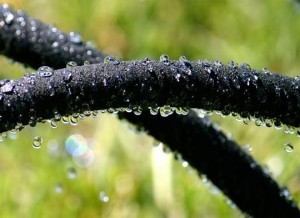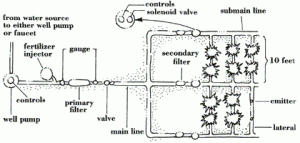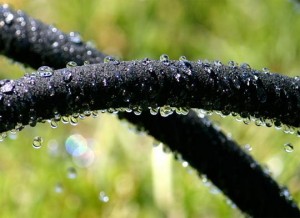Watering a pepper garden may sound as easy as busting out a watering can or a garden hose but if your garden is larger than a couple of 4×4-ft raised boxes from Home Depot, well, you might want something more advanced, like the garden irrigation setups we’re going to discuss.
Sprinklers. Overhead sprinkling works fine when the plants in the garden are small. But once they gain some height, the water from the sprinkler is blocked and the garden is not watered evenly. Because it is awkward to keep raising the sprinkler above the foliage, at this point another watering method should be used.
Flood Irrigation. This method, which simply floods the garden with water from a hose, works well in a garden with good drainage, and is recommended for ridges and furrows, flat beds, and modified irrigated beds. The gardener should carefully watch the amount of time it takes the water to drain from the plot and adjust the amount of water applied to avoid over-irrigating. After the hose is turned off, the water should drain from the garden in less than an hour. If it takes any longer, too much water has been applied and the gardener should use less water more frequently.
Soaker Hoses. Also called “drip hoses,” these leaky hoses are made from recycled tires and can replace drip irrigation systems (below) in smaller gardens. If the water pressure is too high, they tend to rupture and sent sprurting water all over the place. However, this can be controlled by placing heavy mulch, such as wood chips over the hoses to retain the water in the garden. Dave uses this method in his raised beds, and it works well–it’s also an inexpensive system.

Soaker hoses like this work well.
Drip Irrigation. Also called trickle irrigation, this method uses small plastic tubes to apply slow but steady amounts of water to each plant in the garden. The main advantages of drip irrigation are that it conserves water because less is lost to evaporation, and it efficiently delivers water to individual plants. However, there are disadvantages to the system. It is expensive, and the tubes, valves, and other components are subject to breaking, clogging, getting cut with shovels or hoes, and generally falling apart. The drip system must be constantly checked to make sure it is delivering water; otherwise, the gardener risks severe drying of plants. As master gardener George Brookbank advises: “Use a drip irrigation system like you would any other irrigation system– don’t expect too much from it.”

Drip irrigation system for a garden.
A number of studies of trickle-irrigated chile peppers in New Mexico indicated that it is the amount of water applied that increases yield–not the method of applying the water. Gardeners using drip irrigation should take care that the soil around peppers remains moist but not wet. They should also have a backup system in case the drip system fails.
Latest posts by Mark Masker (see all)
- 2024 Scovie Awards Call for Entries - 07/07/2023
- 2024 Scovie Awards Early Bird Special: 3 Days Left - 06/29/2023
- 2024 Scovie Awards Early Bird Deadline Looms - 06/25/2023








